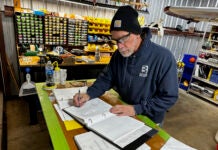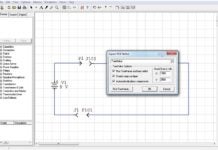I thought I’d start this article out with a fancy definition of what a connector is, but when I looked in the dictionary for a good explanation, I found it simply states a thing that connects! Well, because thats pretty obvious and also not helpful to our discussion, we’ll take a closer look at connectors as they relate to airplanes.

Generally, connectors are used more for convenience than necessity. They allow an airliner to have a complete engine change done in hours instead of days, and they let us quickly and easily remove things from our airplanes (like wings, lights and avionics) while also making future maintenance easier.
I hear the grumbling from the back of the room already. Yes, a continuous piece of wire from source to destination is the theoretical ideal. Fewer connections discourage problems that range from poor mechanical attachment (wire to pin/socket as well as pin to socket), corrosion between pins and sockets, and the potential for getting wires crossed in a connector. So while the one-wire rule is theoretically ideal, it is terribly impractical. After all, you must have a certain number of connections, starting at the battery, down through each switch, circuit protection and then to the very device you’re talking about. Connectors are a way of life, and the few additional ones you might install are a small risk if you know what you’re doing.
Nature of the Beast
Connectors are something that most every homebuilder will deal with at some point in the build project. They can be used to join electrical power wires, signal wires, pitot/static tubing, fluid lines and just about anything else. Because there are literally thousands of connector types, it is impossible to discuss each one in detail. Detailed descriptions of each connector and its relative part numbering schema, mil specs and more are available on the web if you desire more information.

Our focus will be on the most common electrical connectors used in our aircraft by the average builder and pilot. One important subject to keep in mind when working with electrical connectors is the gender of the connector. When someone asks you if you need a male or female, it can often be confusing. No need to worry because it’s quite simple. Electrical connectors are gendered by their pins. For example, a male BNC connector often is mistaken for a female because the main body of the connector acts as a receptacle, but the center pin is a male. It’s the same for most other connectors. You can determine if it’s male or female by the pin in the body of the connector, not the outside shape.
Take a Ride in Your D-sub?
The first and most often referred to connector when we discuss avionics in particular is the D-sub (formally, D subminiature) connector created by ITT/Cannon in the early 1950s. Also known simply as a D or DB connector, there are many variations, but these are now commonly used on most avionics, some ignition systems, engine systems and more.
Their name comes from the fact that when looking at the connector vertically, it has a vaguely D shape to it. Most commonly configured with 9, 15, 25 or 37 pins, they are available in what is called standard density or high density. The standard-density connectors typically have pins that are sized for 20- to 26-gauge wire and with special pins that can accept larger sizes. The high-density D-sub connector will have more pins or circuits fit within a similar form factor. For example, a 9-pin standard-density connector can house 15 high-density pins. Obviously, the high-density pins are smaller in diameter than the standard-density pins.

The easiest way to quickly identify whether your connector is standard density or high density is to look at how many rows of pins it has. In our aircraft installation, a standard-density connector will usually have two rows of pins, and a high-density connector will have three. It is important to know which one you’re dealing with when you go to purchase extra pins or tools, because the high-density pins will not always work with standard-density tools. Also, D-sub connectors will be either solder type (the pins are molded into the connector body with little cups to which you solder the wire) or crimp-and-poke type (you crimp pins onto the wire and poke them into the connector body).

In most cases the crimp-type D-subs are preferred to the solder type because installation errors are reduced by using standard tools. The solder-type D-subs rely on the builder and his skill with soldering tiny wires into very small pins. Properly assembled, both will give excellent performance, but the truth is the crimp connectors are faster, easier and more reliable for our homebuilts.
It’s important when looking at a pinout or pin assignment for DB connectors that you know if the view on the install page is from the front or from the back. Any good connector will have the pin numbers embossed into the body of the unit, but often they are impossible to see without bright light and a magnifying glass. If you know the relation of the picture to your specific connector, you can simply count from a known starting point to find the pin you are looking for.
Say Ahhh to Molex
Many pieces of avionics you might use will have long, rectangular connectors on them with square pins. These are commonly referred to as Molex Card Connectors or Molex KK connectors. They are typically dual row (though they may be single row), and when installed on a tray are mated to an exposed circuit board/card on or in the avionics unit being installed. These are typical for many Narco, Bendix/King, Icom and other equipment that is usually older generation. (All current Garmins use D-sub connectors, both standard- and high-density.)
These connectors use square pins that need to be crimped onto the wire with the appropriate tool. Many times the pins can then be soldered if you desire. The connectors are oriented into the tray through the use of a polarizing key, which is a small piece of plastic (typically white) inserted between the top and bottom row of the connector between two pins or circuits. This key is mated to a slot in the card on the avionics unit, and because these connector shells are rectangular in shape and easily reversible, this device ensures you are installing them correctly. This is very important with some units such as the ubiquitous KX155/165 radios, where the two identical connectors are installed one upright and the other upside down. (I wish I had some of what that engineer was drinking when he came up with that!)

Compounding the issue with orienting these connectors properly is the numbering system. With card connectors, it’s not as simple as just starting at one end and counting. Because most card/Molex connectors are dual row with one row being letters and the other row being numbers, it can be confusing. The numbers simply start at 1 and progress until the end of the connector. However, the letters start at A, but then progress as follows: A, B, C, D, E, F, H, J, K, L, M, N, P, R, S, T, U, V, W, X, Y, Z. You can see that the G, I, O and Q have been left out to avoid confusion with similar appearing numbers on the same connector.
One last quick piece of advice with these connectors: Removal of the pins can be challenging, but it’s not difficult if you have the correct tool. Because the pins are square, they are held into the connector with a small tab on them that must be depressed to remove the pin. The certified tool costs a lot of money, but you can easily make your own by pounding a piece of thick safety wire flat, beating a paperclip flat, using a bobby pin (if you remember what those are) or a small flat-blade jewelers screwdriver, or by taking an old hacksaw blade and fashioning a tool that is nearly identical to the store-bought one!
Molex with a Filling
There’s another type of Molex connector, perhaps more common now in homebuilts. Officially, it’s called a Mate-n-Lok. There are now many, many variations made by multiple companies, but the standard ones used most often are made by AMP/Tyco. They are available in various sizes and configurations from a single circuit up to 12 circuits. Most are considered universal, which means the connector body can accept both male and female pins. The pins are also available for various wire sizes and again must be crimped with the proper tooling. They can also be soldered if you like. These connectors are most commonly used for larger size wire and in areas such as wingroots where you may want to connect or disconnect multiple circuits at one time (landing lights, nav lights, servos, heated pitot, etc.).


Circular Reasoning
Circular connectors are commonly referred to as Cannon plugs, because ITT/Cannon was one of the early manufacturers. They obviously are circular in shape, and can be manufactured from a number of different materials including nylon, aluminum, steel or some other mystery material (Swiss cheese?). You may also hear them called CPC connectors, which stands for circular plastic connector. The size and configuration can range from a single pin/circuit all the way up to 150+ and physical size from fractions of an inch to 3 inches or larger. (Take Jim Weir’s advice and browse the Mouser catalog to see just whats available.) These connectors are commonly also used for firewall penetrations, pressure bulkheads or other areas where a good seal needs to be maintained or a large number of circuits need to be connected. They are available in solder or crimp type, but due to the huge variety of configurations available, it’s almost impossible to recommend a standard for homebuilders. If you must use circular connectors, then stick with the simplest ones such as the CPC series. They are relatively easy to work with, and the pins are crimped just like many other open-barrel types of pin/socket.
Circular connectors are a bit more complex to assemble, as they usually have a main body, a backshell and many times an additional strain relief for the bundle, so care must be taken to route the wires through the appropriate pieces in the correct order to assure you can assemble the entire unit after all wires are inserted into the connector.


Simple Town
Have you considered using the D-sub machined pins themselves with no connector body? Simply crimp or solder a male pin to one wire, crimp or solder a female socket to another wire, and then push them together. A covering of heatshrink will hold them in place until you need to remove them. This solution is most commonly used for very thin wires (22 to 26 gauge) such as trim motors where you don’t often need to disconnect them, and they give you a semi-permanent installation.
Overall, the use of connectors is almost compulsory at some point in your airplane. However, if you go crazy with connectors and put them on every single wire, you’ll just be asking for trouble. Gremlins like to take up residence in connectors, so it’s best if you don’t have too many of them and don’t use them where they aren’t necessary. Like I said, there are literally thousands of types of connectors available, and I’ll bet homebuilders over the years have used most of them. You are free to use whichever connector you like, but picking a standard type of connector will make assembly and future maintenance easier. Just remember that if you do a poor job putting the connectors together, performance will suffer, as will reliability. If you do a good job assembling, good performance and reliability will be your reward.













